|
|

|
|


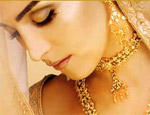 No bridal outfit would be complete without ornate jewellery, and when it comes to
Indian bridal jewellery the obvious choice is gold. In India,
No bridal outfit would be complete without ornate jewellery, and when it comes to
Indian bridal jewellery the obvious choice is gold. In India, 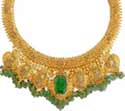 marriage and jewellery are inseparably interlinked. Jewelery
has
many connotations, both aesthetic and ritual. The wearing of jewellery is
supposed to endow the women with qualities of power and authority, as well
as
great beauty.
marriage and jewellery are inseparably interlinked. Jewelery
has
many connotations, both aesthetic and ritual. The wearing of jewellery is
supposed to endow the women with qualities of power and authority, as well
as
great beauty.
 Gold has traditionally symbolised wealth and prosperity within
Indian culture, holding special significance in celebrations such as weddings and births. Often presented as a gift or tangible form of investment, this precious metal features heavily in most
Indian weddings. Ornaments such as the mangalasutra, bindi, ear rings,
bangles,
nose rings and
rings are presently worn by brides almost all over the country. Some of the
important traditional ornaments like armlets, waste bands etc
Gold has traditionally symbolised wealth and prosperity within
Indian culture, holding special significance in celebrations such as weddings and births. Often presented as a gift or tangible form of investment, this precious metal features heavily in most
Indian weddings. Ornaments such as the mangalasutra, bindi, ear rings,
bangles,
nose rings and
rings are presently worn by brides almost all over the country. Some of the
important traditional ornaments like armlets, waste bands etc are not in vogue
today and are not worn in all areas.
are not in vogue
today and are not worn in all areas.
Rings are the most traditional form of wedding jewellery for both men and women, and universally symbolises a marriage between two individuals.
In Indian marriages, the additional adornment of a 'mangal sutra' or 'thaali' (a
small gold pendant worn on a thread or necklace ) is the main symbol of
matrimony. Tying a thaali around the neck of the bride by the groom, is the most
important ceremony in Indian marriages. Wearing of 'chura' (set of red bangles
given to the bride from her maternal side of the family) and toe rings (which
the bridegroom puts on the brides toes) are also traditional symbols of
marriage. The kind of ornament, of course, depends on the community to
which she belongs and their particular customs. These pieces of jewellery which
she che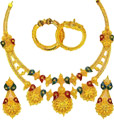 rishes throughout her married life, signifies a married women's status
and is considered auspicious.
rishes throughout her married life, signifies a married women's status
and is considered auspicious.
The traditional 'mangalasutra'
usually in gold, comes in
various forms and sizes -some with auspicious symbols depicting 'Om' or gods
like Vishnu or Shiva (for Hindus) or a cross (for Christians) and others with
traditional designs. Nowadays more fashionable versions with diamonds and
precious stones are also seen. In the south especially in Tamil Nadu and in a
few other states, Thaali's are tied on a thick yellow thread. When the thread is
worn out, they are replaced by a new thread. Generally, in the northern
states Mangalsutra is worn on a chain with two strings of black beads
interspersed with gold. These beads are believed to protect the marriage against
evil. 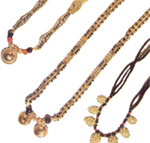
The mangalasutra with vatis (tiny bowls) is a must for every Maharashtrian bride, the Gujarati bride sports the typically Gujarati Mangalasutra interspersed with gold and black beads with a pendant in a traditional design.
The Punjabi bride usually chooses as her mangalasutra the kundan (traditional Indian stone setting with thin gold foil forming a wedge around the stones) pendant set in 22-carat gold and held together with black beaded chains. Also set in 22 carat gold is the Hyderabadi mangalasutra with seven pendants attached.
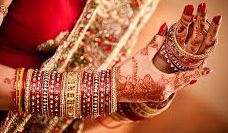 Other
than the Mangalasutra, in North India, many women deck their arms with bangles
in vivid green and red. And the chooda that is presented to the bride by her
mama as a symbol of her newly married status, is one which she has to wear for
at least 40 days after her marriage. The chooda is traditionally a set of ivory
bangles with inlay work. The modern day variations can be found
in cheaper forms in plastic or acrylic as well. In Uttar Pradesh and Bihar, bichwa or toe rings must be worn by all married
women. After marriage, the Sindhi women prefer to wear the traditional gold earring
each studded with nine diamonds. Further north, after marriage, the Kashmiri Brahmin women wear the
'dejhoru' and 'aathhoru', an ornament worn in the pierced cartilage of the ear with a cord
suspended from it at one end. Among the Muslims, the nose ring is obligatory at
the time of marriage.
Other
than the Mangalasutra, in North India, many women deck their arms with bangles
in vivid green and red. And the chooda that is presented to the bride by her
mama as a symbol of her newly married status, is one which she has to wear for
at least 40 days after her marriage. The chooda is traditionally a set of ivory
bangles with inlay work. The modern day variations can be found
in cheaper forms in plastic or acrylic as well. In Uttar Pradesh and Bihar, bichwa or toe rings must be worn by all married
women. After marriage, the Sindhi women prefer to wear the traditional gold earring
each studded with nine diamonds. Further north, after marriage, the Kashmiri Brahmin women wear the
'dejhoru' and 'aathhoru', an ornament worn in the pierced cartilage of the ear with a cord
suspended from it at one end. Among the Muslims, the nose ring is obligatory at
the time of marriage.
Traditional or modern, the varieties of Indian jewellery available are numerous and the choices limitless. Each part of India offers their own traditional ornaments with special significance and these typically traditional ornaments with slight variations remain trendy at all times.